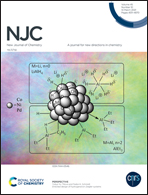An ESIPT-based colorimetric and fluorescent probe with large Stokes shift for the sensitive detection of hypochlorous acid and its bioimaging in cells†
Abstract
Hypochlorous acid (HOCl), with a low physiological concentration, plays a vital role in killing the pathogens and anti-inflammation in the human immune system. Deviation from the normal concentration is directly related to the inflammation-associated diseases and even cancer. Thus, it is necessary to sensitively detect the tiny concentration changes of HOCl. However, few of the reported probes could practically work well due to small Stokes shift, high detection of limits, and low SNR. In this study, HBT (2-(2′-Hydroxyphenyl)benzothiazole) was used as the candidate for the ESIPT-based fluorophore and connected to pyridine via “C![[double bond, length as m-dash]](https://www.rsc.org/images/entities/char_e001.gif) C” bonds. The “C
C” bonds. The “C![[double bond, length as m-dash]](https://www.rsc.org/images/entities/char_e001.gif) C” bonds are the reaction site for HOCl and are activated by the strong electron-withdrawing CN group located on the double-bond carbon atom, resulting in a high sensitivity towards HOCl. Thereby, the probe's emission shifted effectively to the red channel avoiding the interference from biological autofluorescence. The excellent response of the probe JBD towards HOCl enables it to detect endogenous hypochlorous acid in the cells and provides an ideal molecular tool for exploring the mechanism of hypochlorous acid in oxidative stress and its immune role.
C” bonds are the reaction site for HOCl and are activated by the strong electron-withdrawing CN group located on the double-bond carbon atom, resulting in a high sensitivity towards HOCl. Thereby, the probe's emission shifted effectively to the red channel avoiding the interference from biological autofluorescence. The excellent response of the probe JBD towards HOCl enables it to detect endogenous hypochlorous acid in the cells and provides an ideal molecular tool for exploring the mechanism of hypochlorous acid in oxidative stress and its immune role.



 Please wait while we load your content...
Please wait while we load your content...